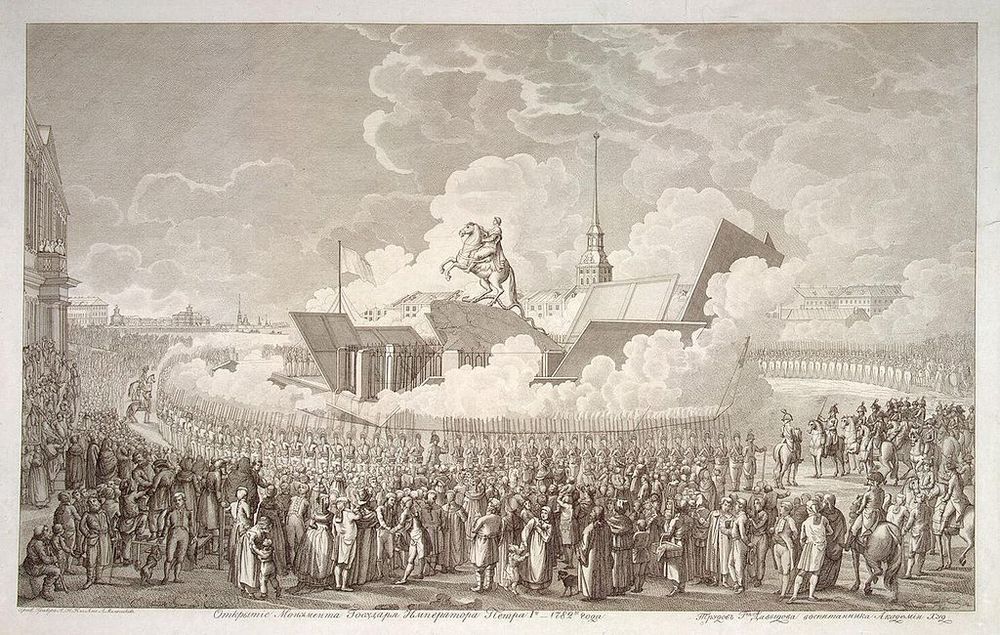At the Senate Square in Saint Petersburg, Russia, stands a magnificent equestrian statue of the founder of St Petersburg, Peter the Great. Known as the Bronze Horseman, after a classic poem by Alexander Pushkin, the statue was commissioned by Catherine the Great as a tribute to her famous predecessor. Being a German princess who married into the Romanov line, Catherine had no legal claim to the throne and wanted to represent herself as Peter's rightful heir. Anxious to connect herself to Peter the Great to gain legitimacy in the eyes of the people, she hired French sculptor Étienne Maurice Falconet for the job. The statue was unveiled in 1782 and portrays Peter the Great sitting heroically on his horse, his outstretched arm pointing towards the River Neva. The horse is seen trampling a serpent, variously interpreted to represent treachery, evil, or the enemies of Peter and his reform. The statue itself is splendid, but it’s the pedestal on which it stands that interests me more.
The Bronze Horseman. Photo: Matt Malto/Flickr
The Bronze Horseman stands on an enormous boulder that was originally buried in earth at Lakhta, some 10 km away, as the crow flies. It was unearthed in 1768, transported to its current place and turned into a pedestal for the statue. It was the largest stone ever to be moved by humans.
The boulder is named Thunder Stone based on a legend that thunder split a piece off the stone. The big dilemma for sculptor Falconet was how to move such an enormous boulder all the way to Saint Petersburg. He wanted to work on cutting the rock right where it lay but Catherine the Great ordered it be moved before being cut. The boulder was embedded to half its depth in the ground and the area was marshy terrain, so the first problem was to lift it out of the mud. Marinos Carburis, a Greek from the Island of Kefallonia and who happened to be a lieutenant-colonel in the Russian Army, offered to undertake the project. Carburis had studied engineering in Vienna and is considered to be the first Greek to hold a diploma in engineering.
The Bronze Horseman. Photo: whereisemil/Flickr
Carburis’s plan was to wait for winter, when the ground was frozen, and then drag the large stone over the frozen ground to the sea for shipment and transport to the city. He laid a track and designed a metallic sledge to slid over it, using 6 inches bronze spheres to reduce friction. Although a stupidly simple design, ball bearings would not be officially invented until two decades later when Welsh inventor and ironmaster Philip Vaughan successfully filed a patent for the first modern ball bearing in 1798, notwithstanding the fact that examples of ball bearings are found in historical machines since Roman times.
After Carburis had laid the groundwork, it took 400 men nine months to transport the stone from the its original site of discovery to its final resting place. All the while, stonecutters continued to shape the enormous granite in an effort to shed weight so that its transportation was easier. When it was extracted from the ground, the boulder weighed more than 1,500 tons. By the time it arrived at Saint Petersburg it weighed 1,250 tons. The work of transporting the stone was done entirely by men; no animals or machines were used in the process.
The Transportation of the Thunder-stone in the Presence of Catherine II. Engraving by I.F.Schley.
While the boulder was being transported, Catherine periodically visited the effort to oversee their progress. The larger capstan was turned by 32 men, this just barely moving the rock. A further complication was the availability of only 100 meters of track, which had to be constantly disassembled and relaid. Nevertheless, the workers made over 150 meters of progress a day while on level ground. Upon arrival at the sea a special pier was built as well as an enormous barge exclusively for the Thunder Stone. The vessel had to be supported on either side by two full-size warships. Thankfully, the voyage was short, and the stone reached its destination in 1770, after nearly two years of work. A large crowd gathered on the docks to watch its unloading, which was quite the feat, given the size and weight of the cargo. To unload the stone near the bank of the Neva, a technique was used that had already been used during loading— the ship was submerged and sat on piles previously driven into the bottom of the river, which made it possible to move the stone to the shore.
Opening of the Bronze Horseman on Senate Square, St. Petersburg. Engraving by A.K.Melnikov.
After the boulder was dug out of the ground, it left an enormous pit several times larger than the boulder itself. This pit still exist, as a filled pond, about half a hectare in size. It is surrounded by a rampart of excavated earth rocks. The Petrovsky pond, as it is called, is now a protected area.
Petrovsky pond. Photo: Victor Gleim/Wikimedia Commons

















Comments
Post a Comment